Nusa Lembongan is a small island just a few miles from Bali. For all the diving I’ve done, I wanted to learn more about the coral environments I’ve been diving in for the past few years. So I went to Lembongan to take a three week series of courses on marine ecology, reef health and coral restoration. Each day we dove in the morning and had classes in the afternoon. I also surfed there a few days, which will be at the bottom of this post.
The Island
Nusa Lembongan is tiny island. It is approximately 8 square kilometres in area with a permanent population estimated at 5,000. But with world class diving and surfing, it’s a wonderful playground. You can see on the map below how close it is to Bali. The small island just next to Lemongan is Nusa Cenigan, and behind it is the much larger, but less populated, island of Nusa Penida.
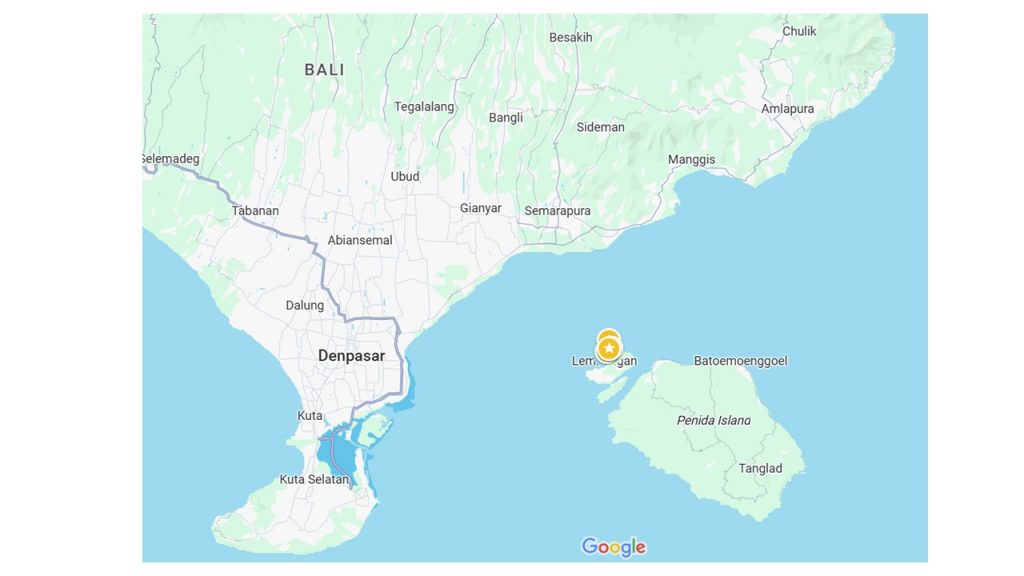
Bali’s majestic Mount Agung towers over the Badung Straight and the beaches of Lembongan.
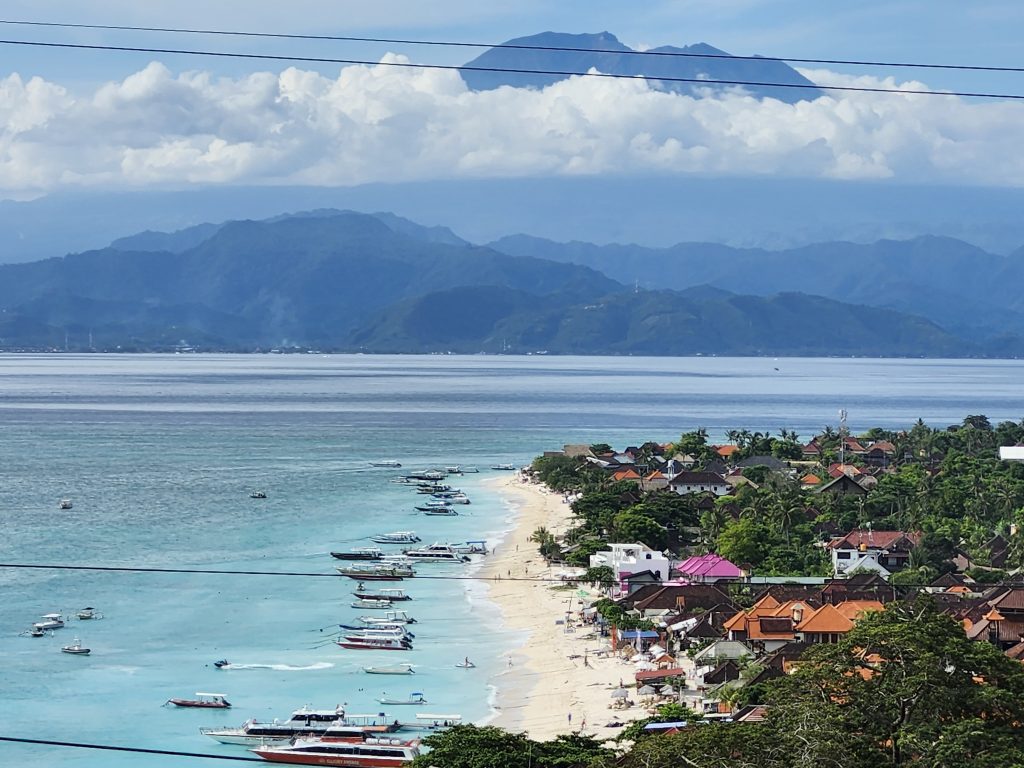
Some scenes of the small, relaxed beaches of Lembongan.
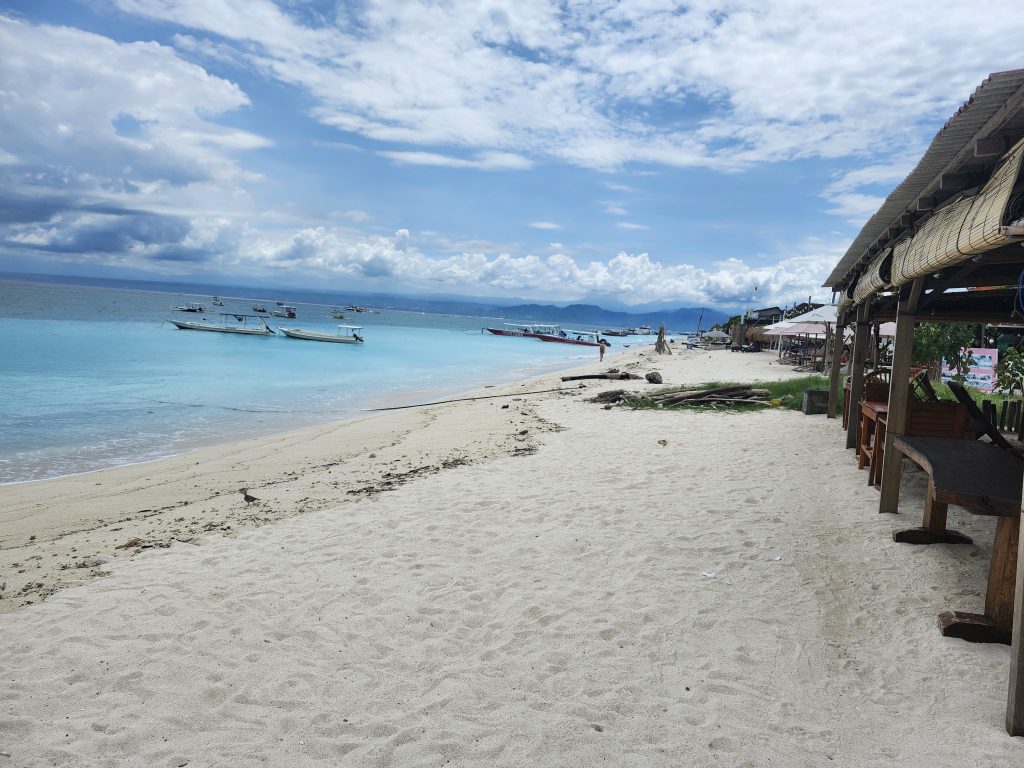
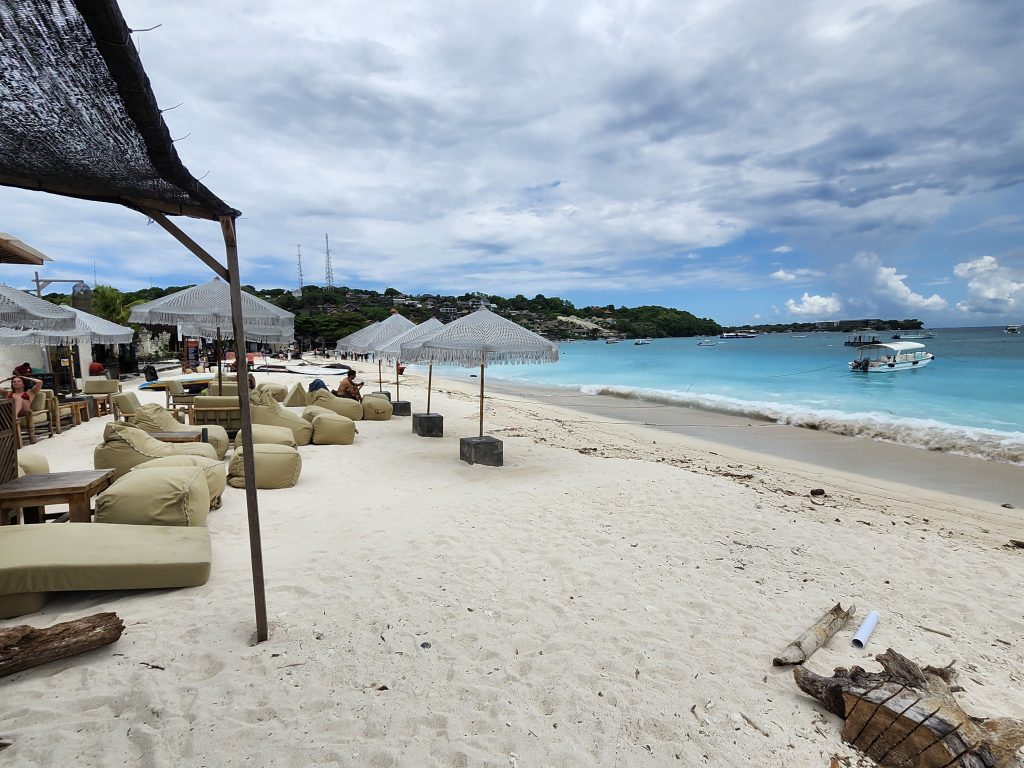
The main road of the island. It has a lot of nice restaurants and shops along it.
A mostly residential street with the traditional Balinese ornaments and entrances.
Going down the road on along the southern bay of the island.
To get to Nusa Cenigan you cross a small yellow bridge.
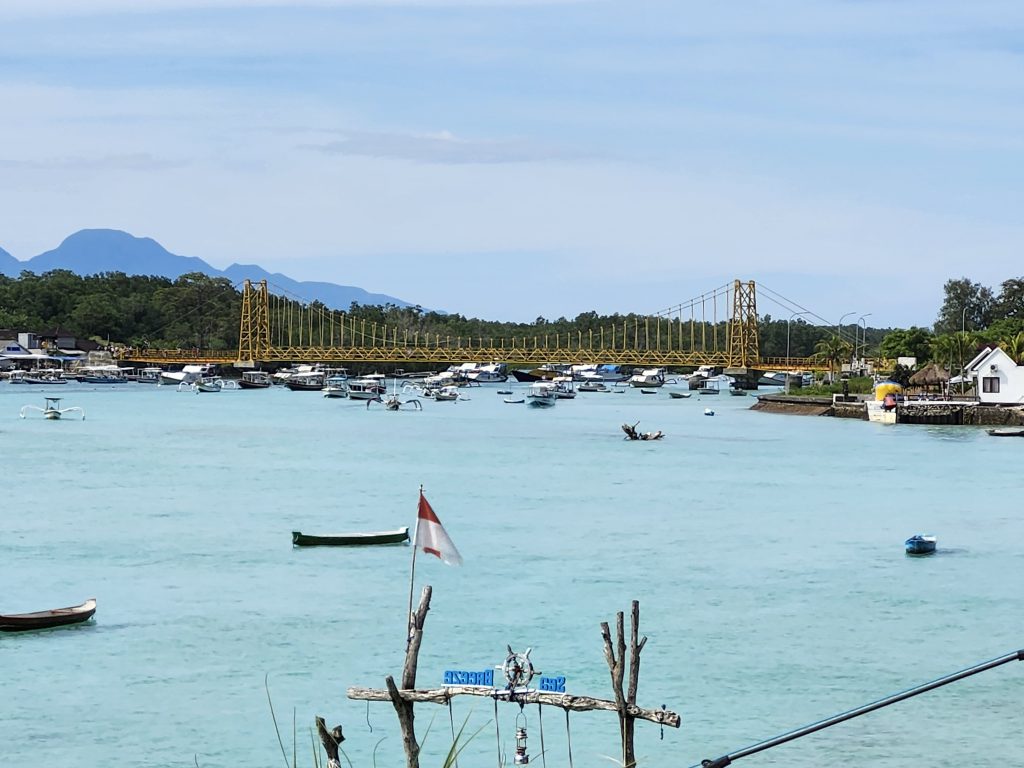
The main road of Ceningan.
Going off the main road down a small residential road. It’s a pretty rustic place.
Through a small trail to the back of the island facing the much larger island of Nusa Penida.
From there the views across the channel to Nusa Penida are wonderful.
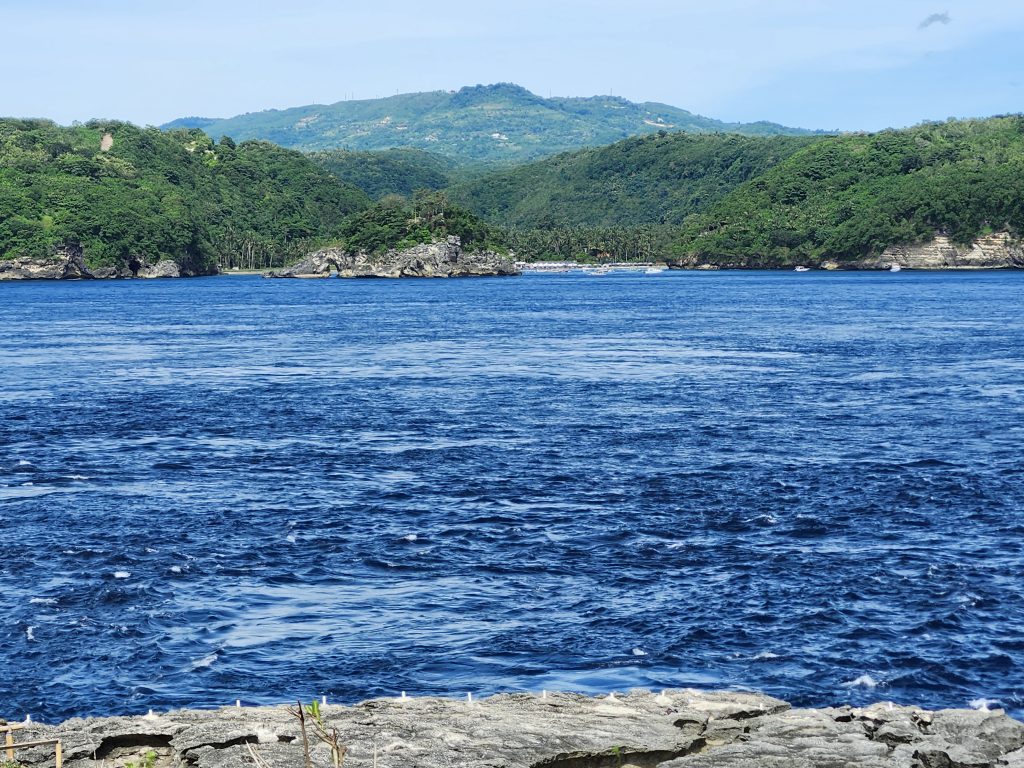
As well as the backside cliffs of Cenigan.
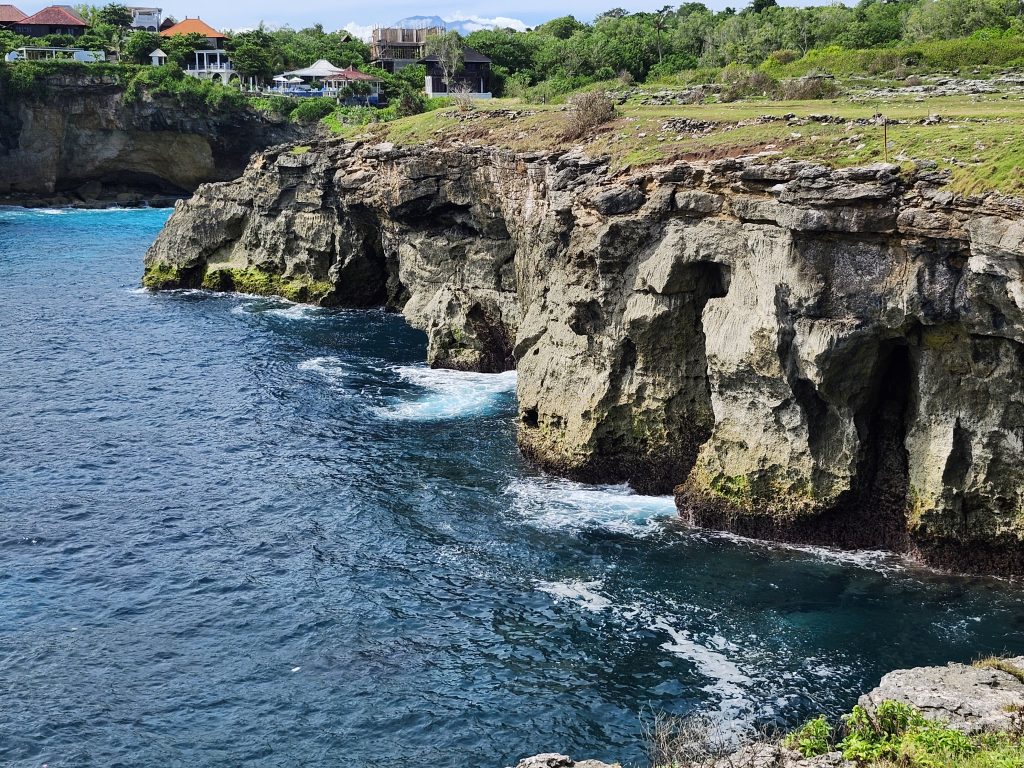
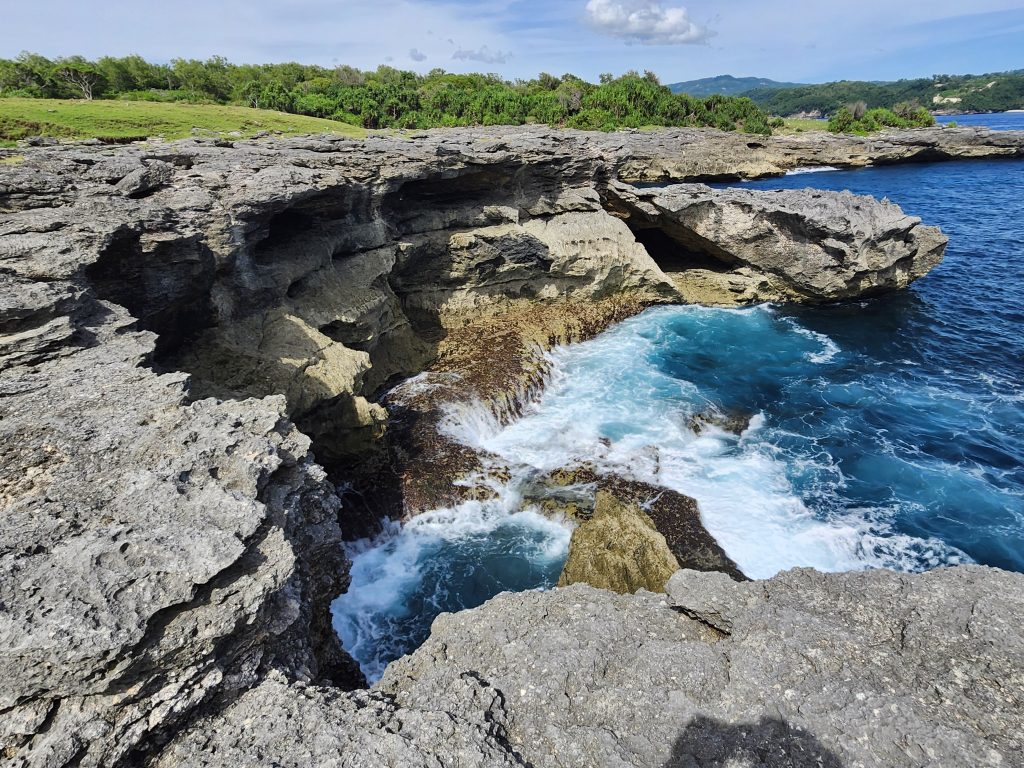
The Diving Classes
I came to Lembongan to take a really highly reviewed three week series of classes on reef ecology, reef health monitoring and coral restoration. The video from Andrew here explains the overall program: https://bluecornerconservation.org
Here’s the books I received for the 3 weeks of classes. And if you want to know more about coral there’s a wonderful book called The Secret Life of Corals by David E. Vaughan.
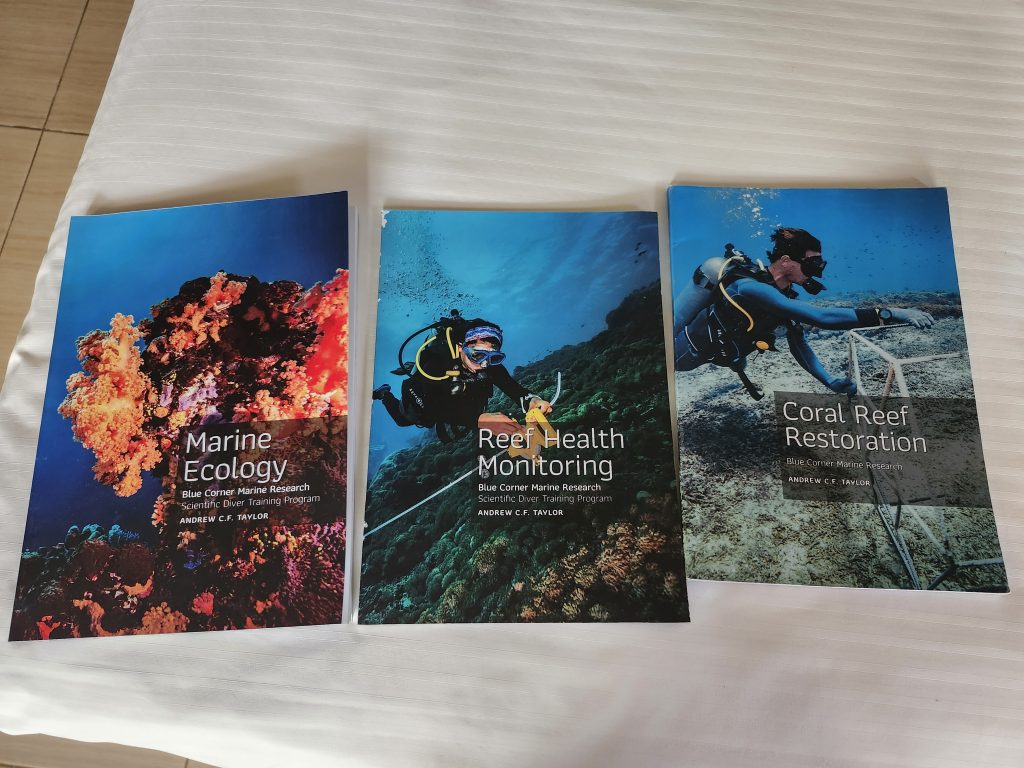
The dive center was large with everything needed and a great staff.
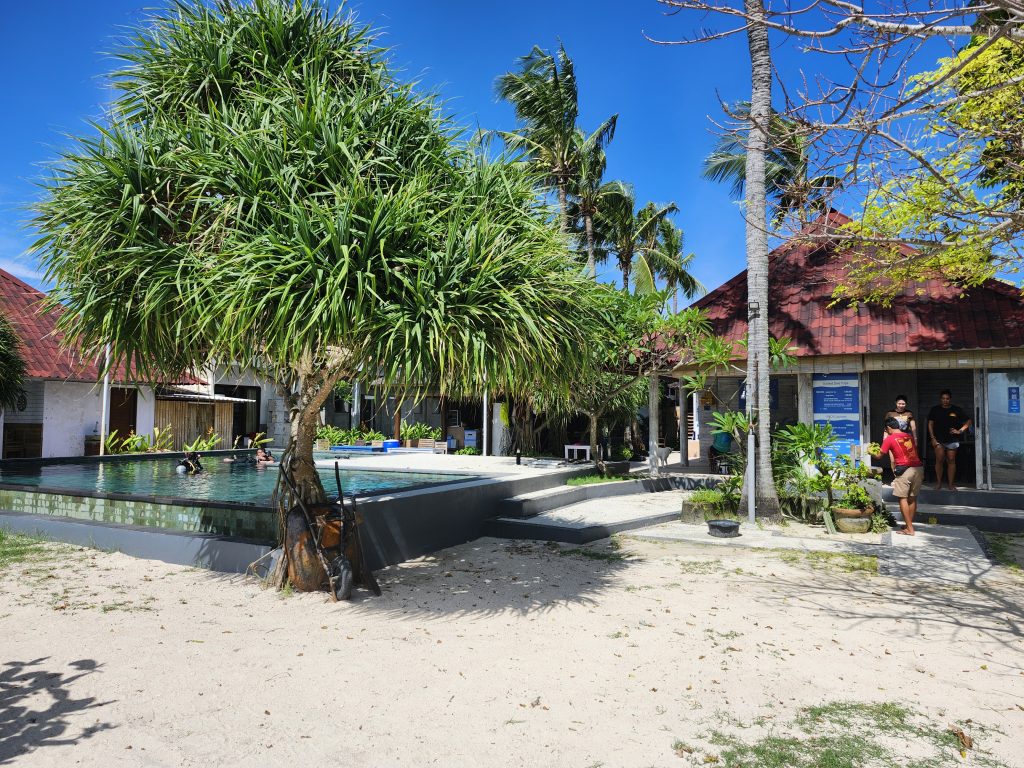
We would dive in the mornings then have classroom sessions in the afternoons.
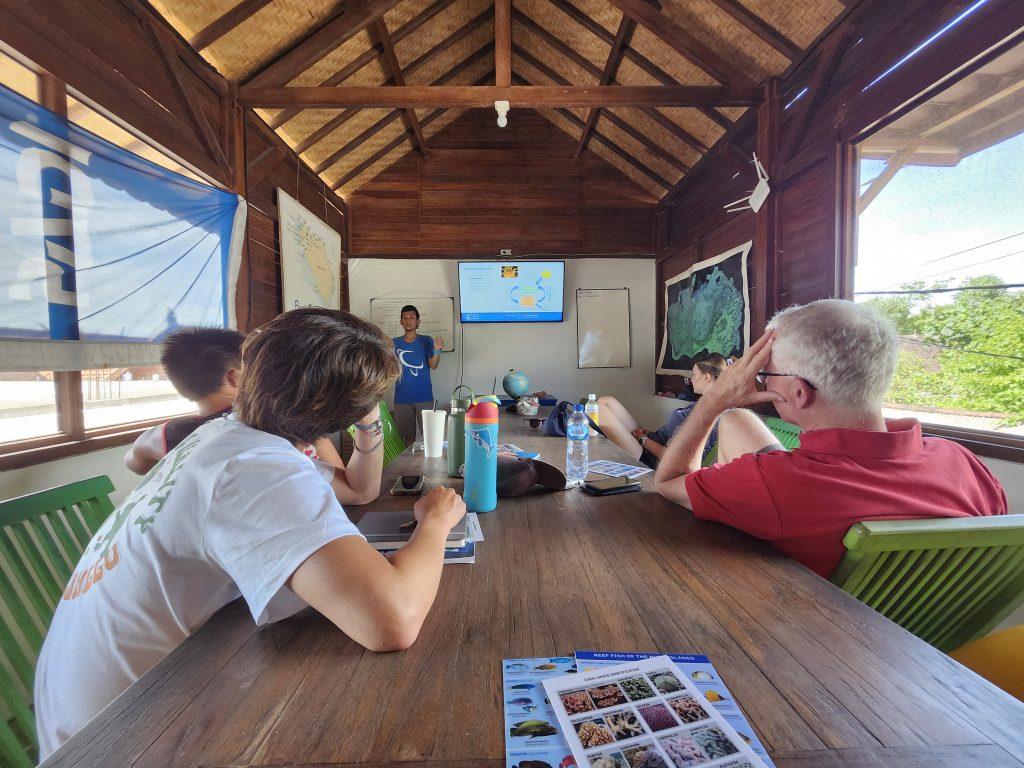
While we were based in Nusa Lembongan the majority of the dive sites were on Nusa Penida.
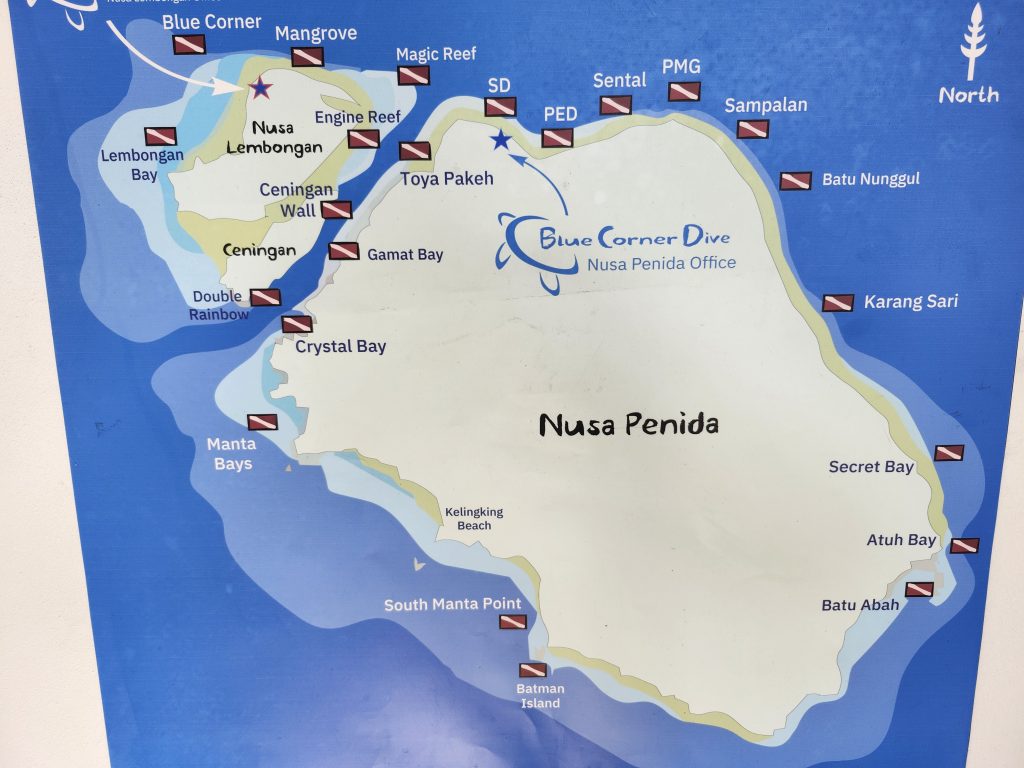
Week One: Marine Ecology
This was a quick, but thorough overview of the basic ecology of the local reefs here. The contents of the book provide an idea of what we covered that week.
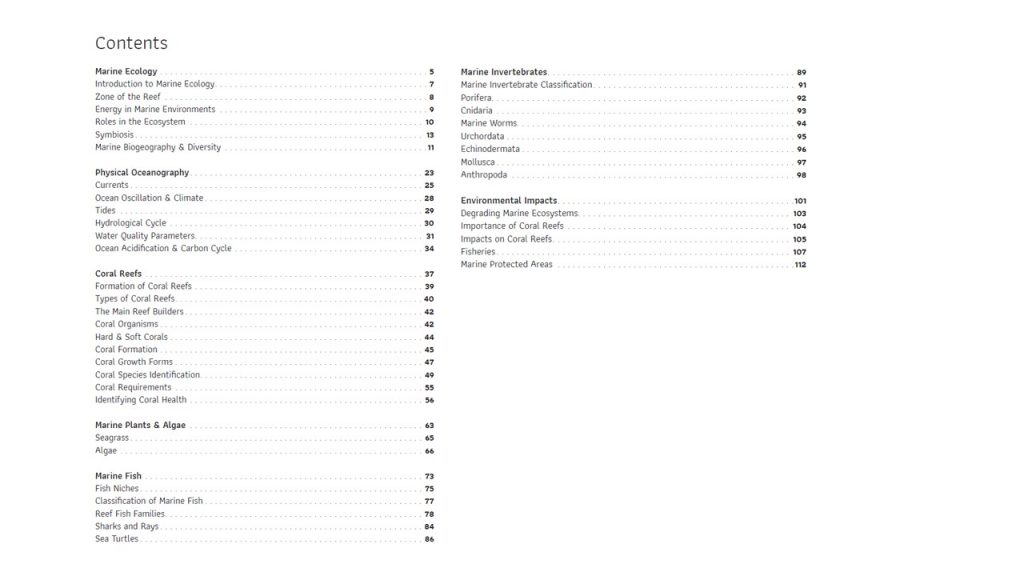
And here’s the diving and classroom components broken out in more detail.
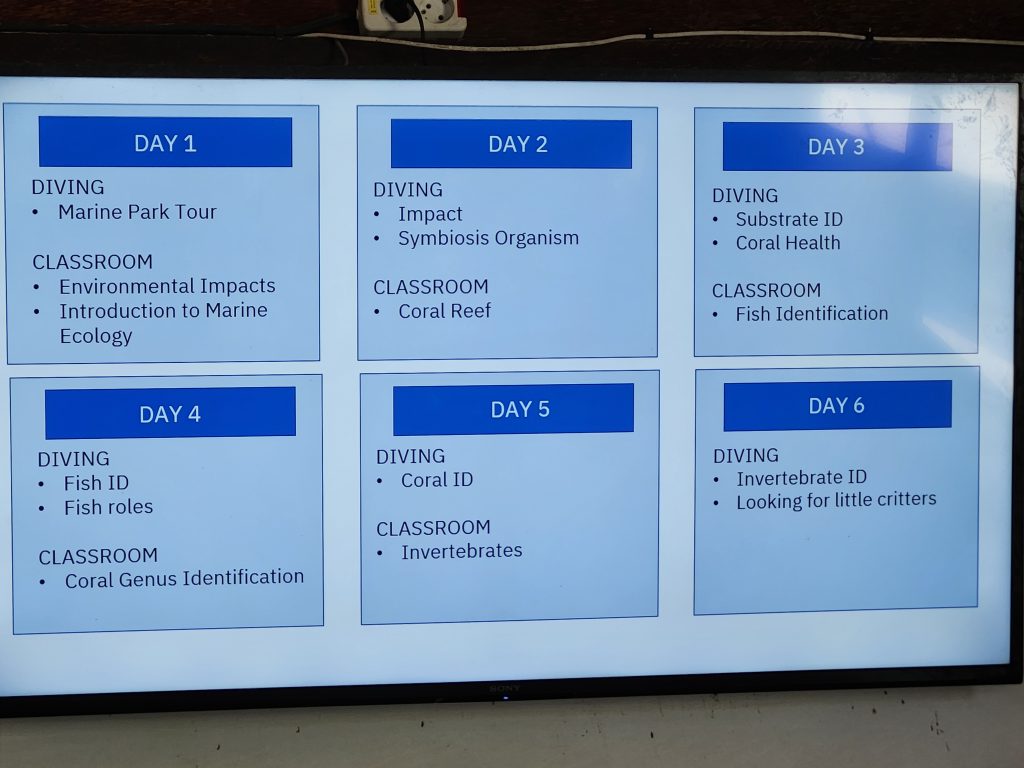
For the fish identification sections they gave us these nice fish guides that we could take underwater with us.
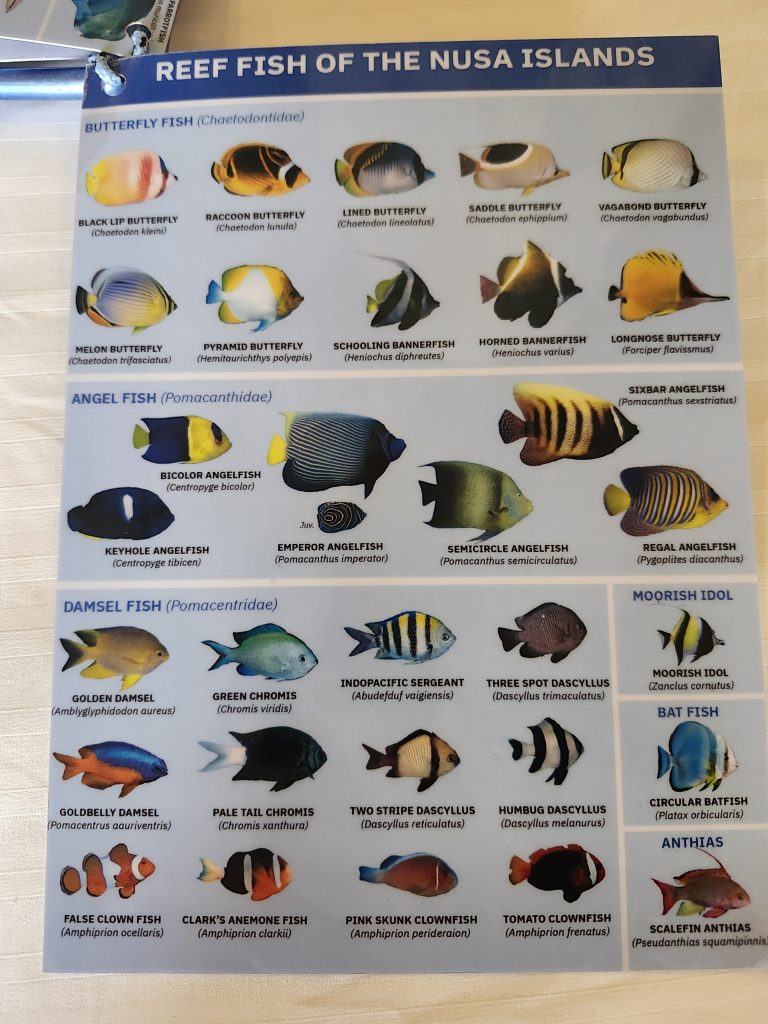
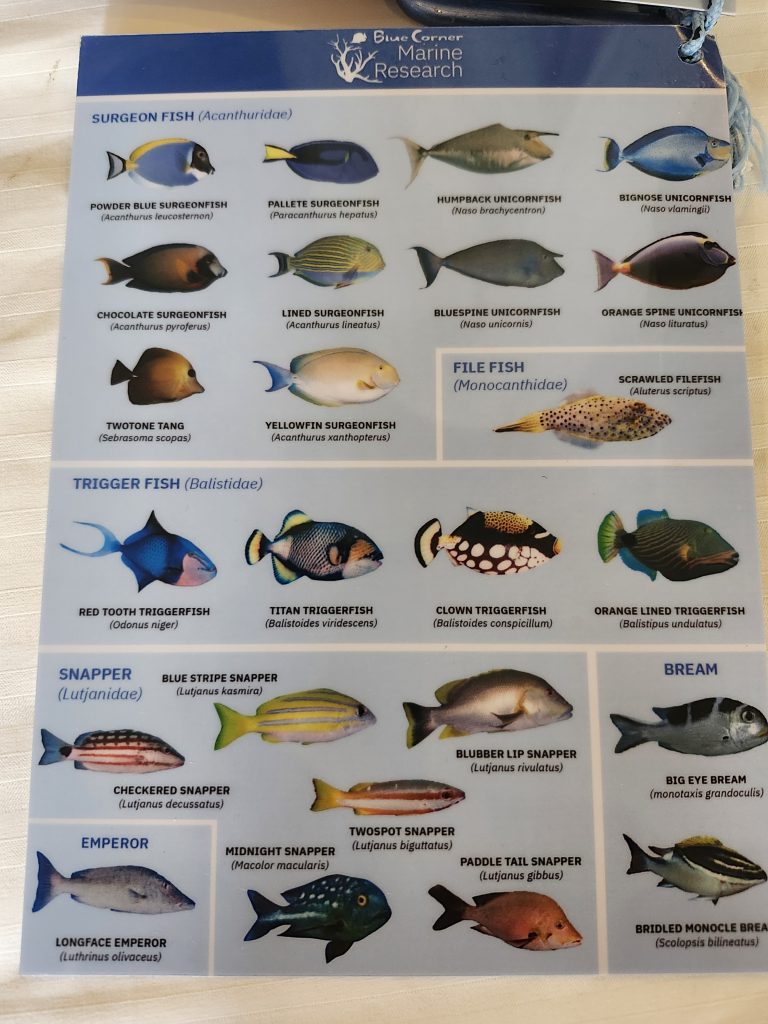
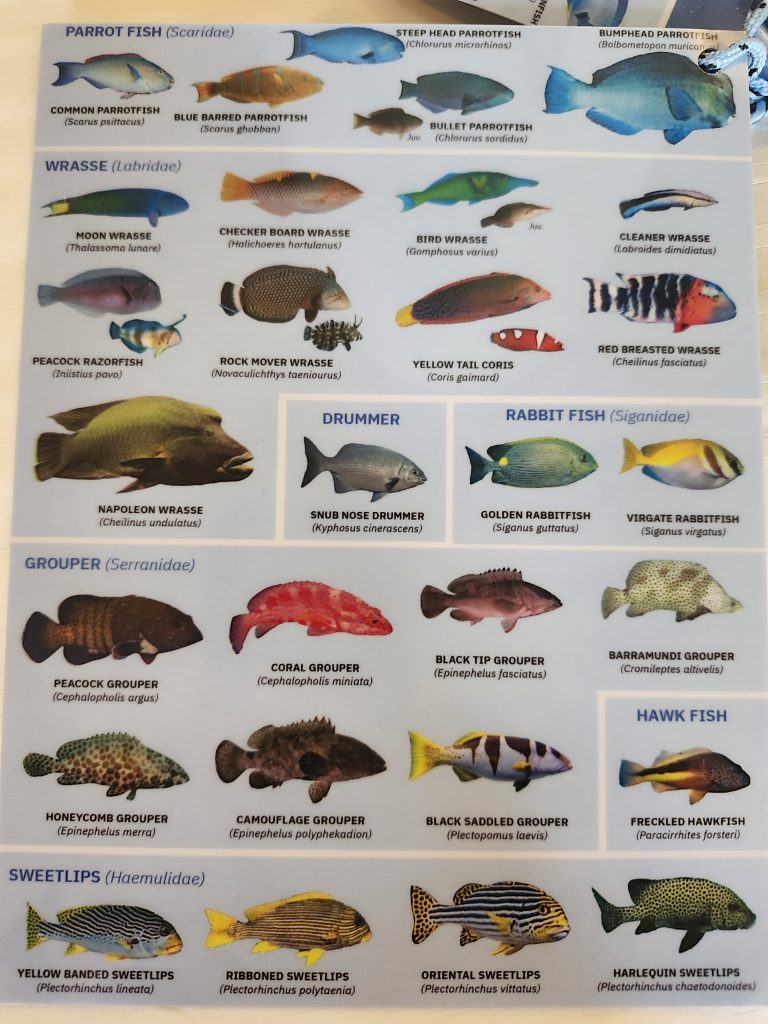
We spent a couple of dives with these tools and the instructor would point out fish for us to identify and then let us know if we got it right or not. There were strong currents the dives we did this, so that added to the challenge of it.
Coral was much more complex to identify than fish, but the fact they don’t move makes up for the complexity in trying to identify them. First, there are the different kinds of shapes coral form.
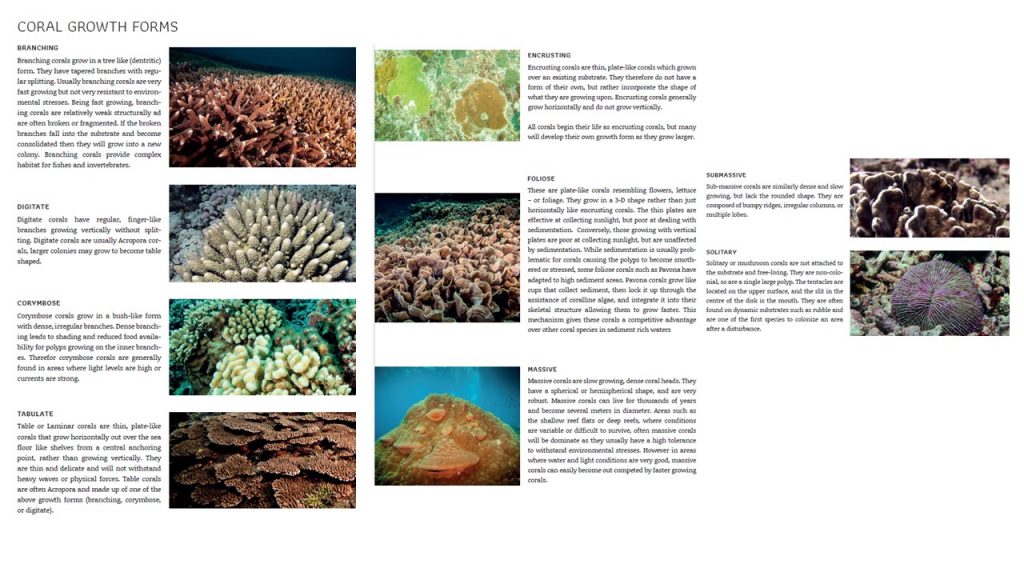
But then there are the actual coral genuses and species, which can take multiple shapes based on the conditions they grow in. This is the underwater ID card we used for the coral ID exercises. Corals are basically upside down jellyfish and one of the keys to the genuses is where the coral mouths were relative to the ridges their tentacles come out of.
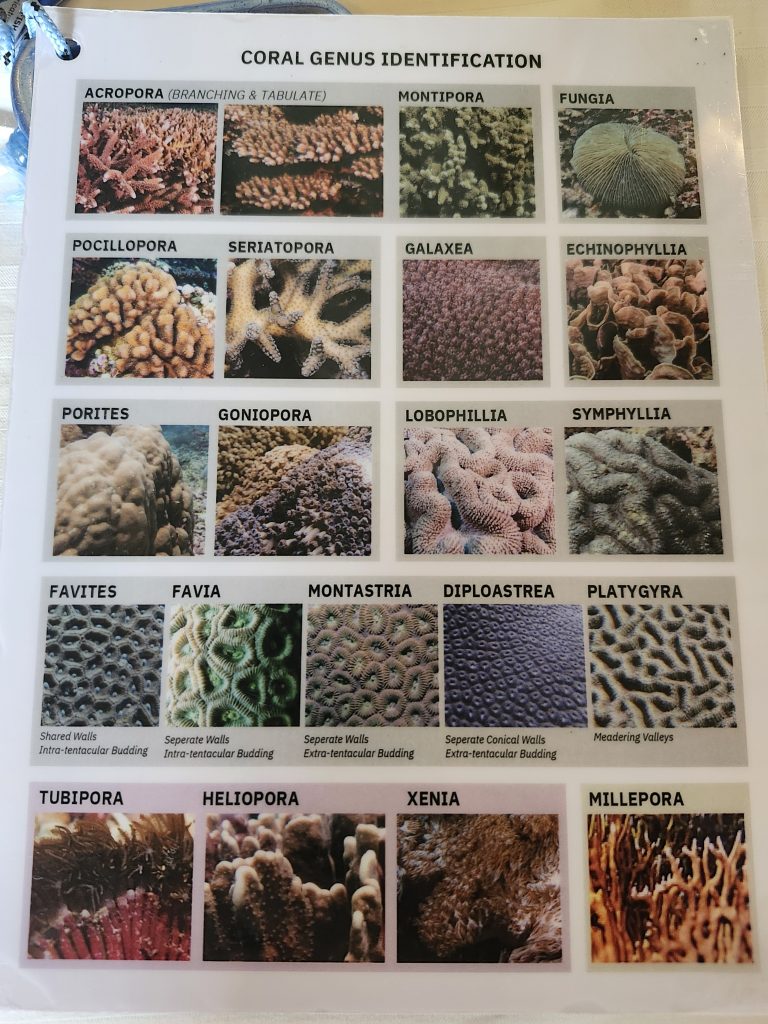
We also did a couple of dives working to identify coral genuses.
After a few classes of this, I’ve got a nice foundation for identifying basic fish species and coral shape categories. Here’s the five students and our instructor after our last dive.
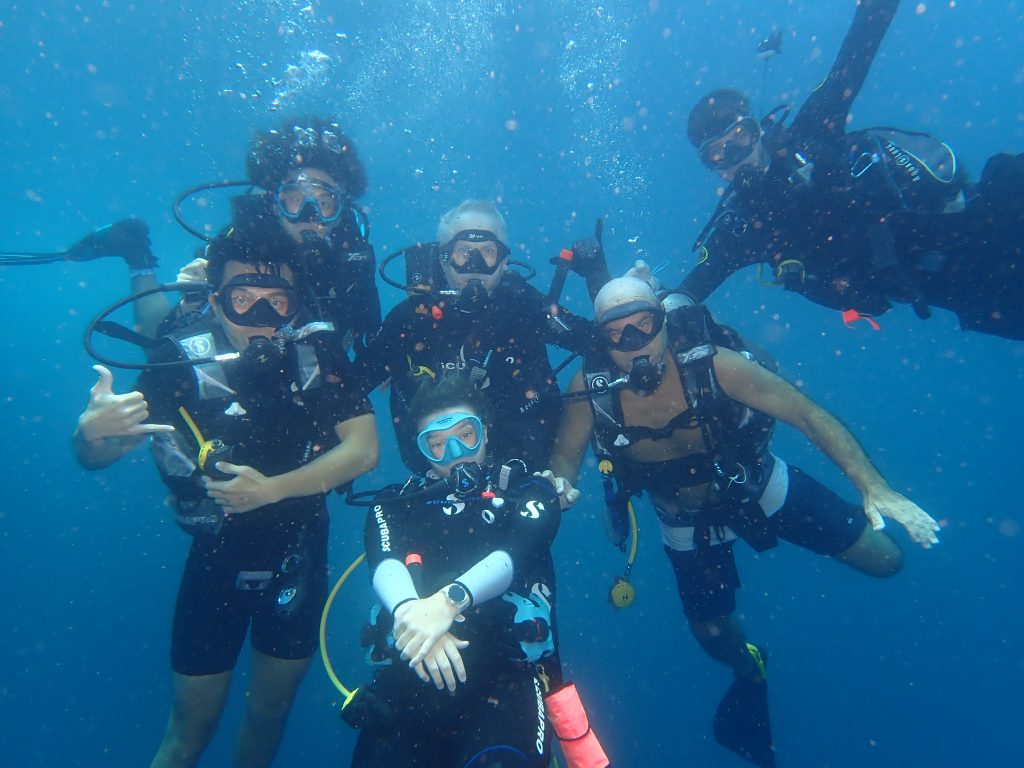
Week Two: Reef Health Monitoring
For the second week we focused on studying the health of coral reefs. The table of contents of the book provided an overview of the topic.
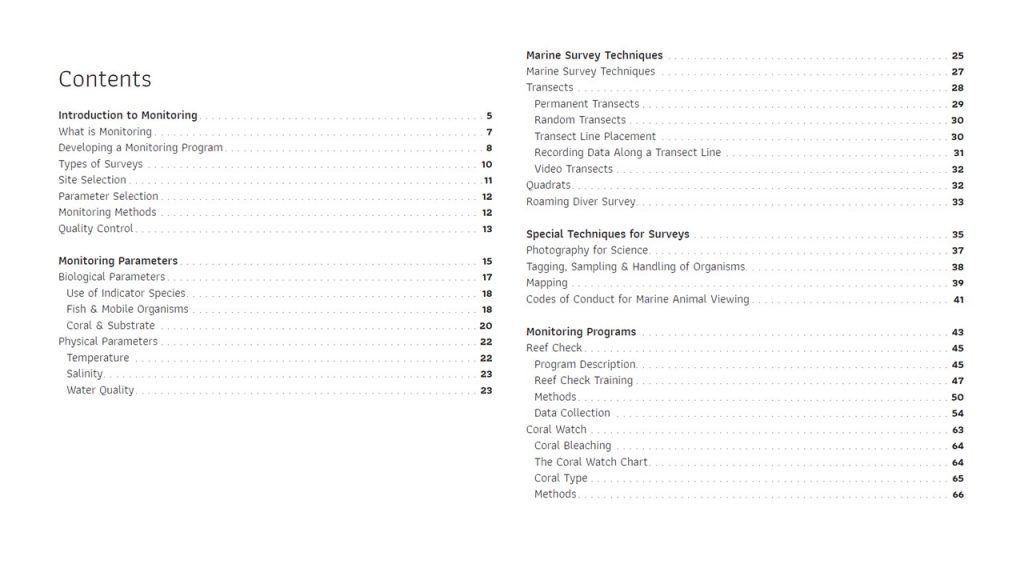
Most of our actual time was learning the official Reef Check protocal which was developed by the Reef Check Foundation to standardize the process of monitoring coral reefs around the world: https://www.reefcheck.org/
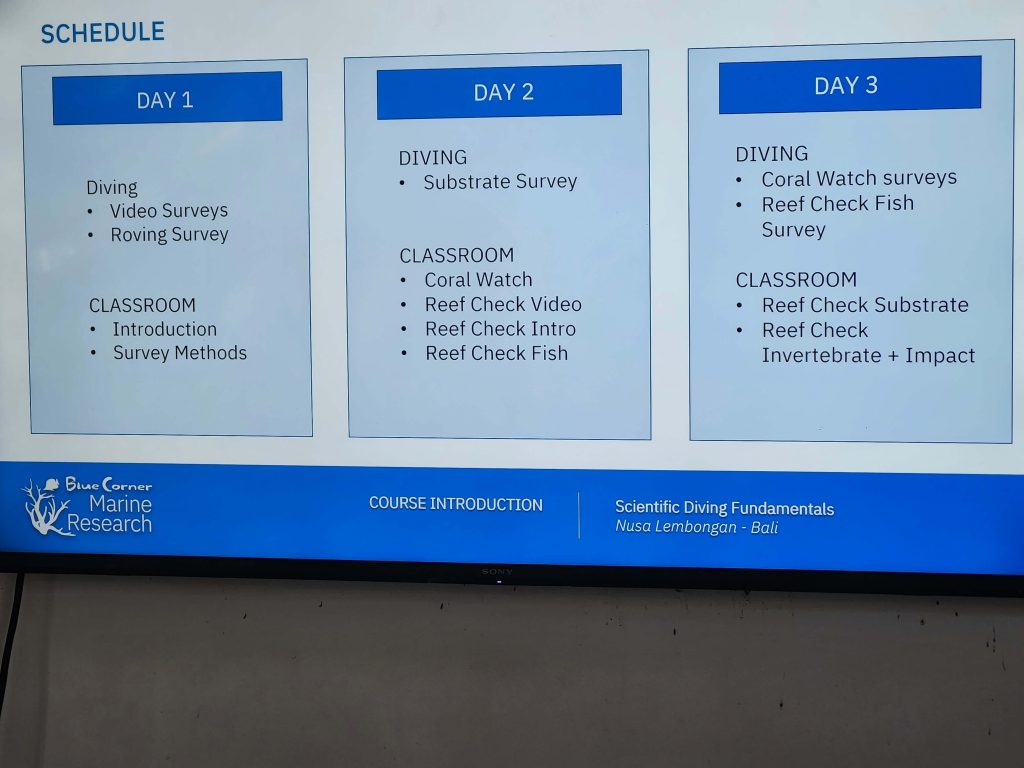
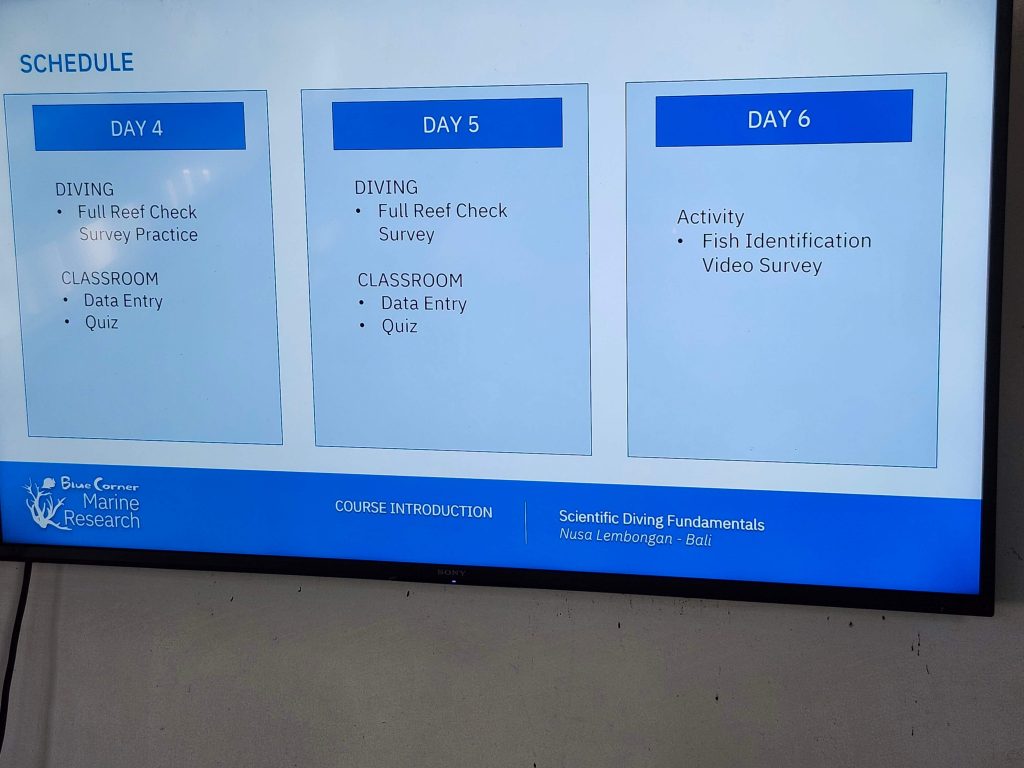
The Reef Check process is pretty straightforward. A team lays out a series of transect tape lines over a 100 meter coral reef area. Here we are rolling up the line after completing a survey.
There is a standard two sided underwater charting slate.
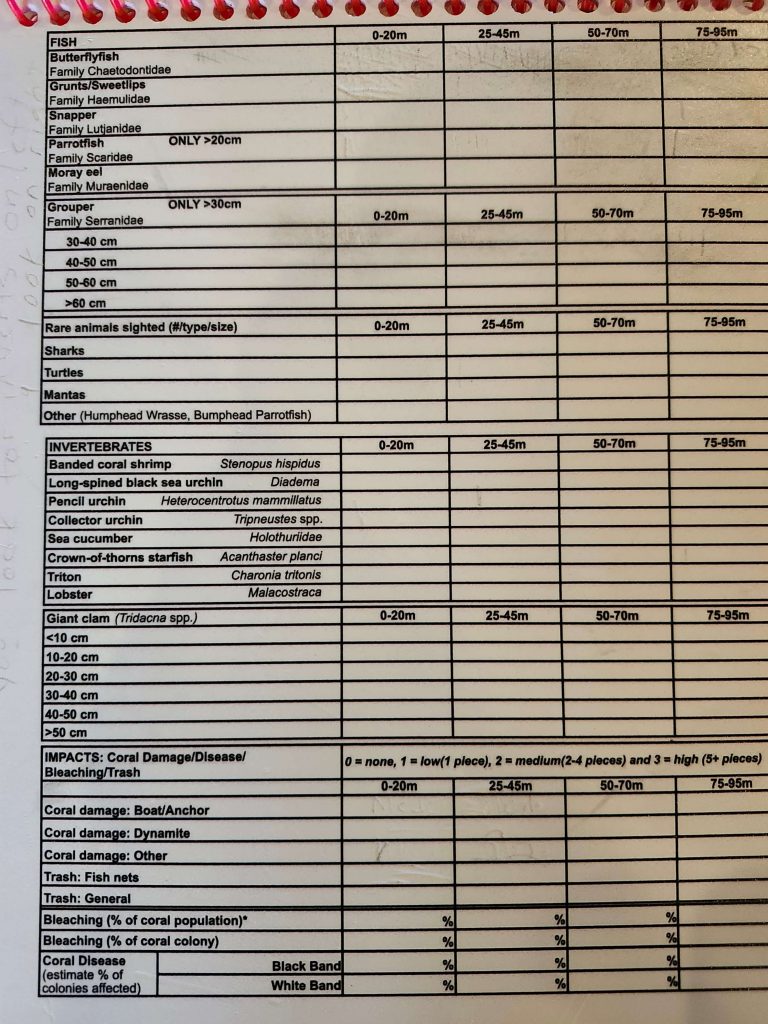
The first person swims slowly over the line and notes the number of key indicator fish species that swim through an imaginary box 2.5 meters on each side of the line and 5 meters high.
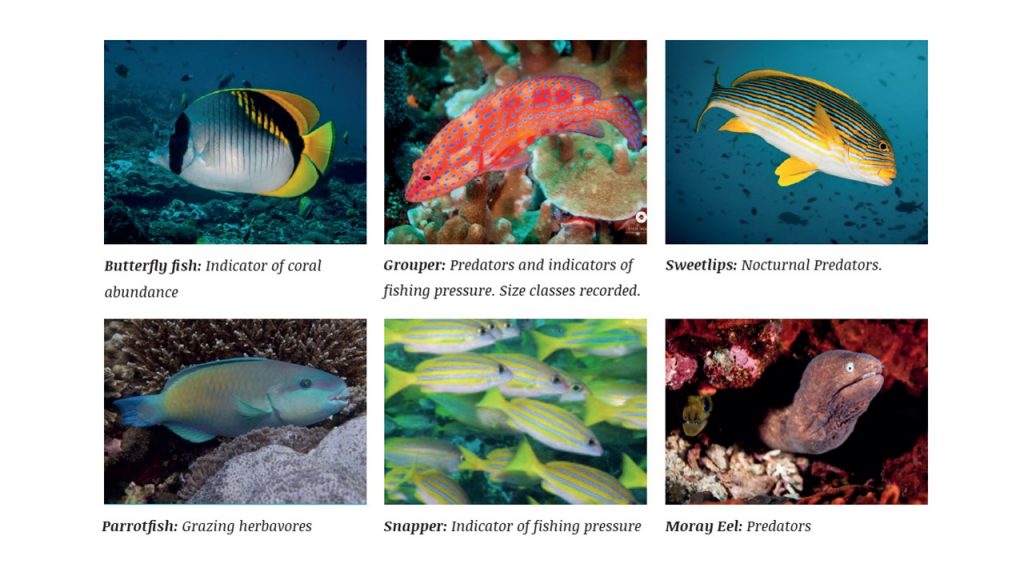
The second person zigzags over the line to look for key local invertebrates over the survey area.
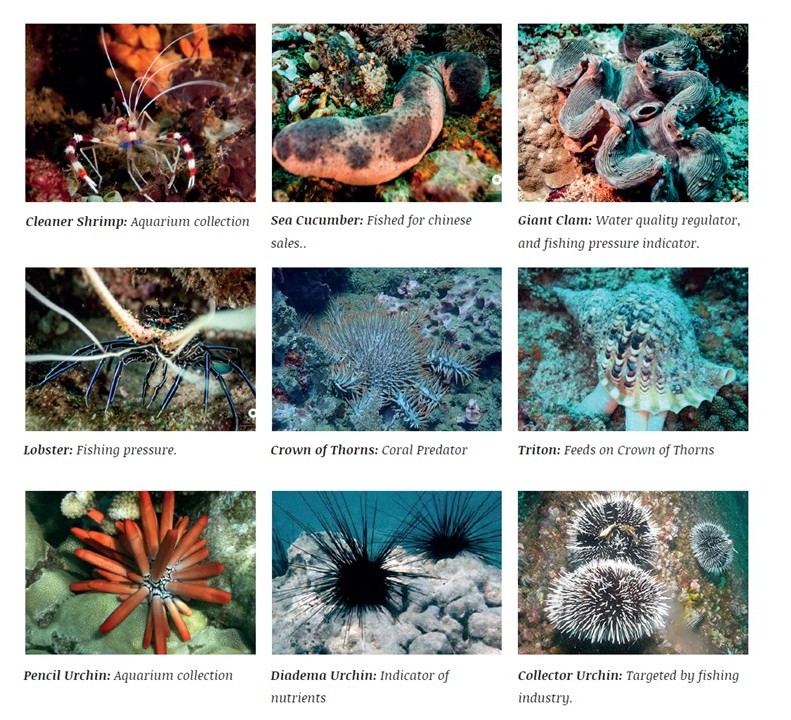
The third person swims over the area and notes the type of impacts as noted on the bottom of the first side of the form.
The fourth person uses the back side of the form to note the substrate components every half meter.
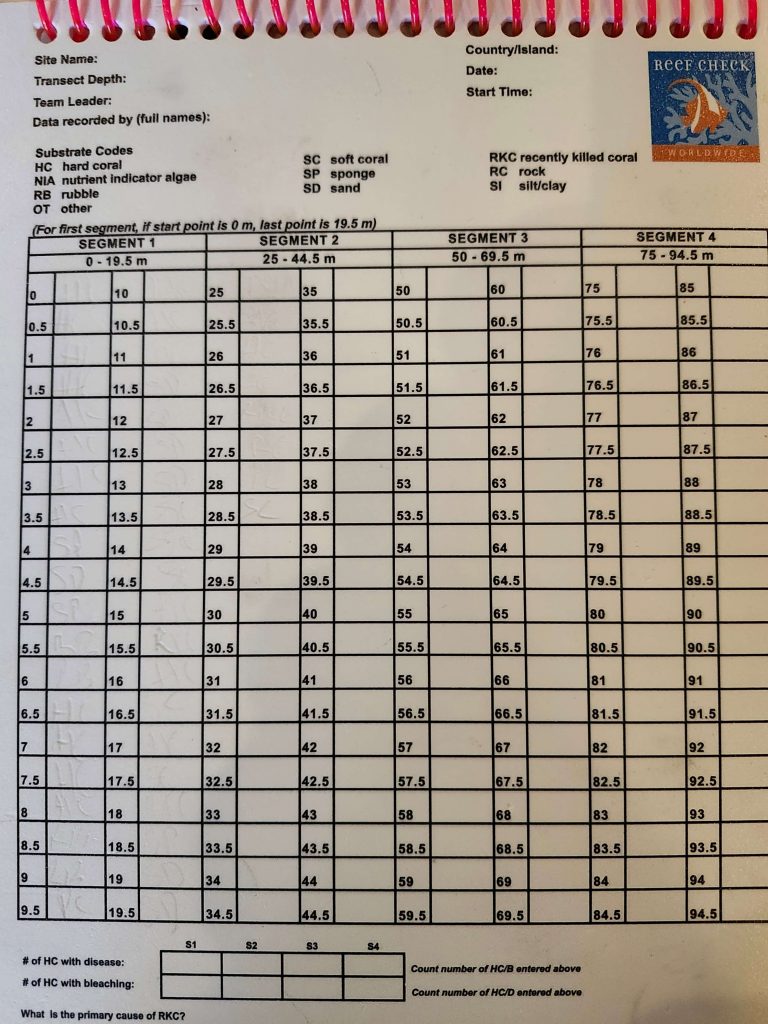
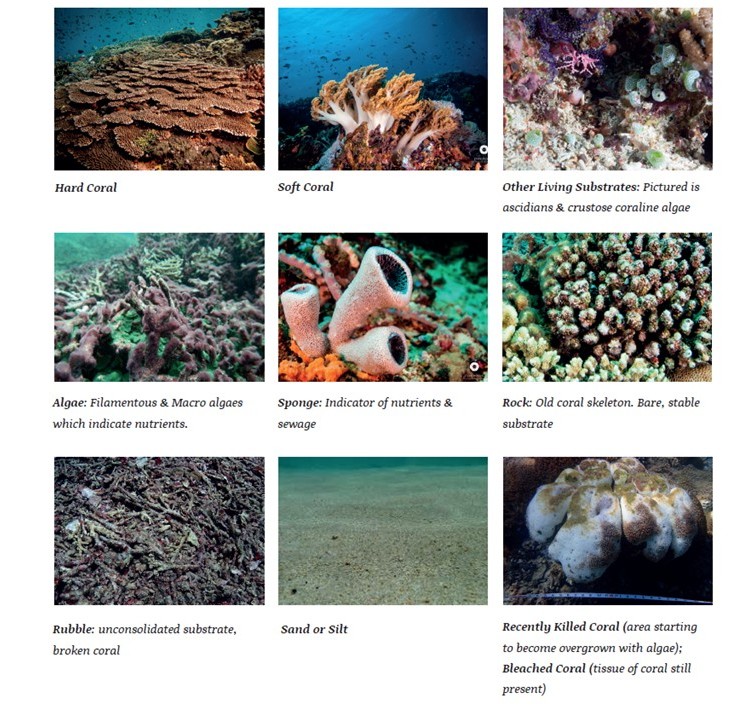
Week Three: Coral Restoration
Week three was the main event where we actually got to start the process of growing new coral. The overall subject matter as covered in the textbook.
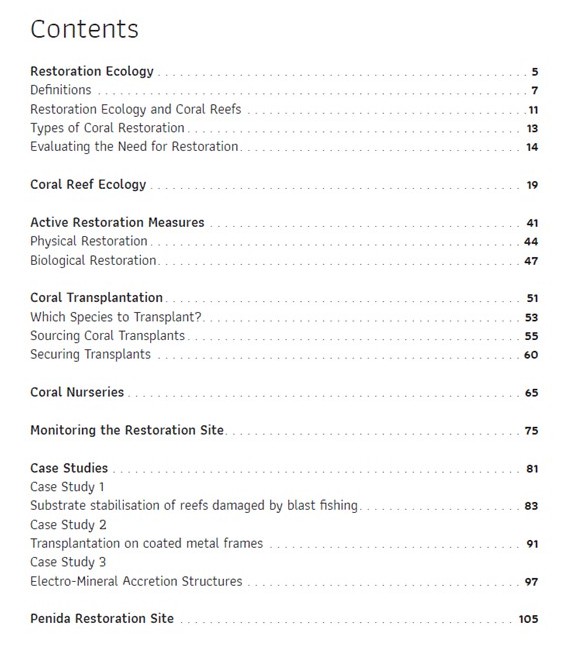
The initial gameplan for the dives and classes.
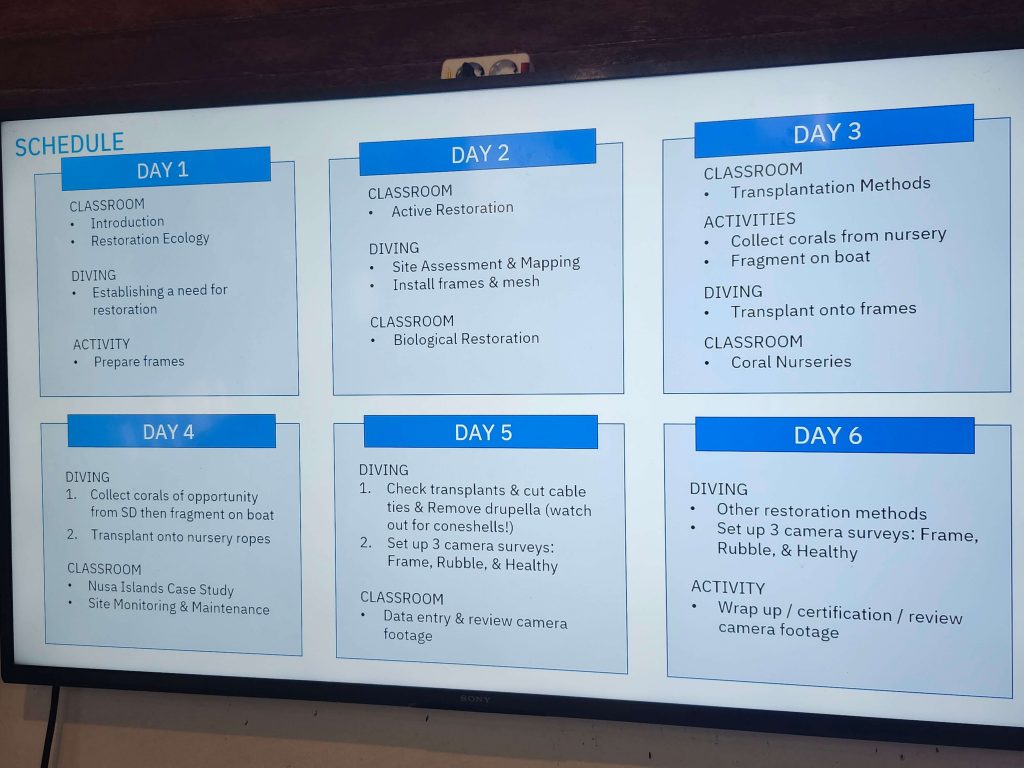
This is a great sequence of pictures to show the success of restoration process at one of the local sites. You can see the site was primarily loose coral rubble from years of boat anchorages and other events that destroyed the coral.
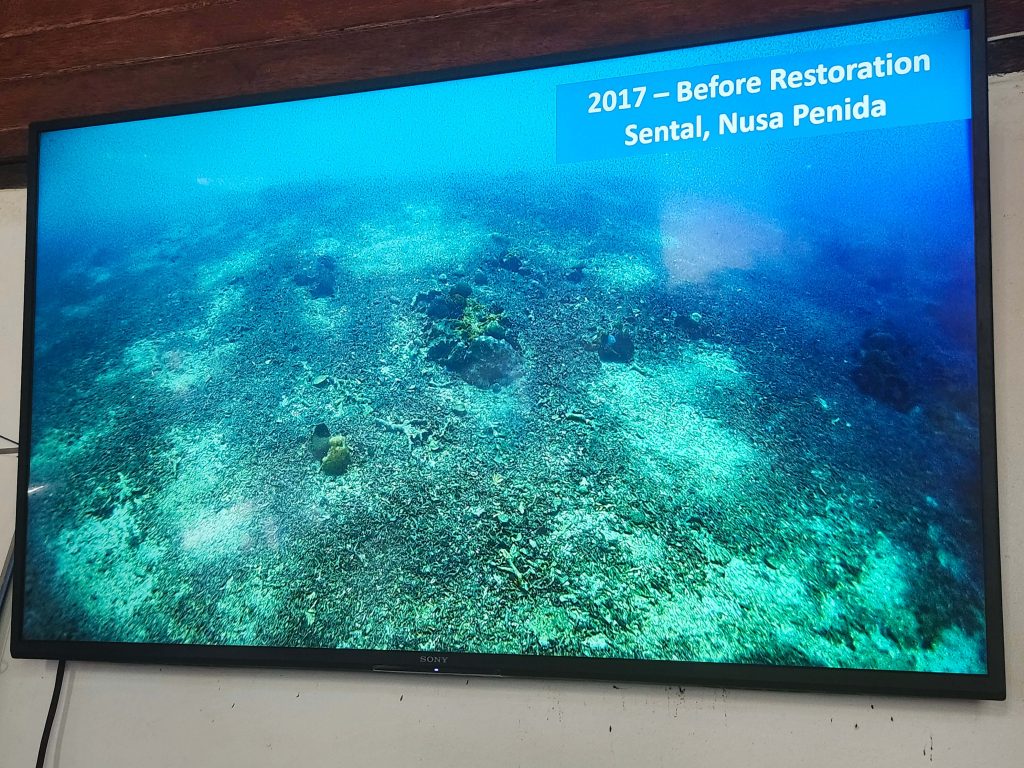
Four years later the frames with the small coral had grown out and provided a foundation for further coral growth.
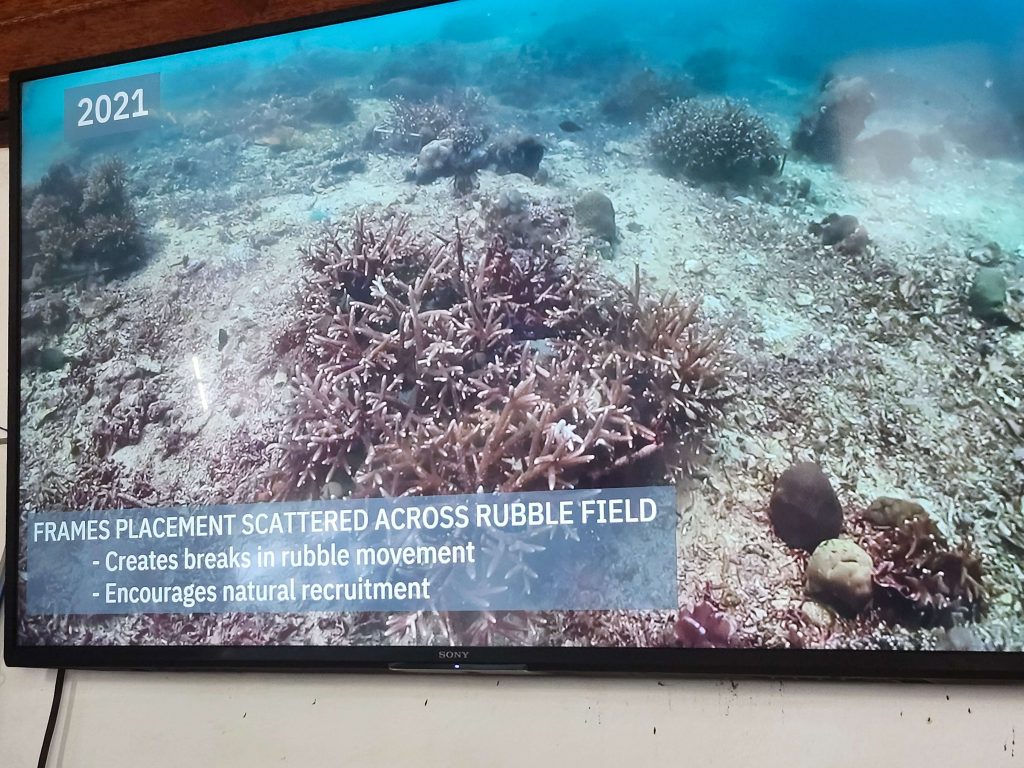
And now portions of the site are beginning to completely fill out with coral.
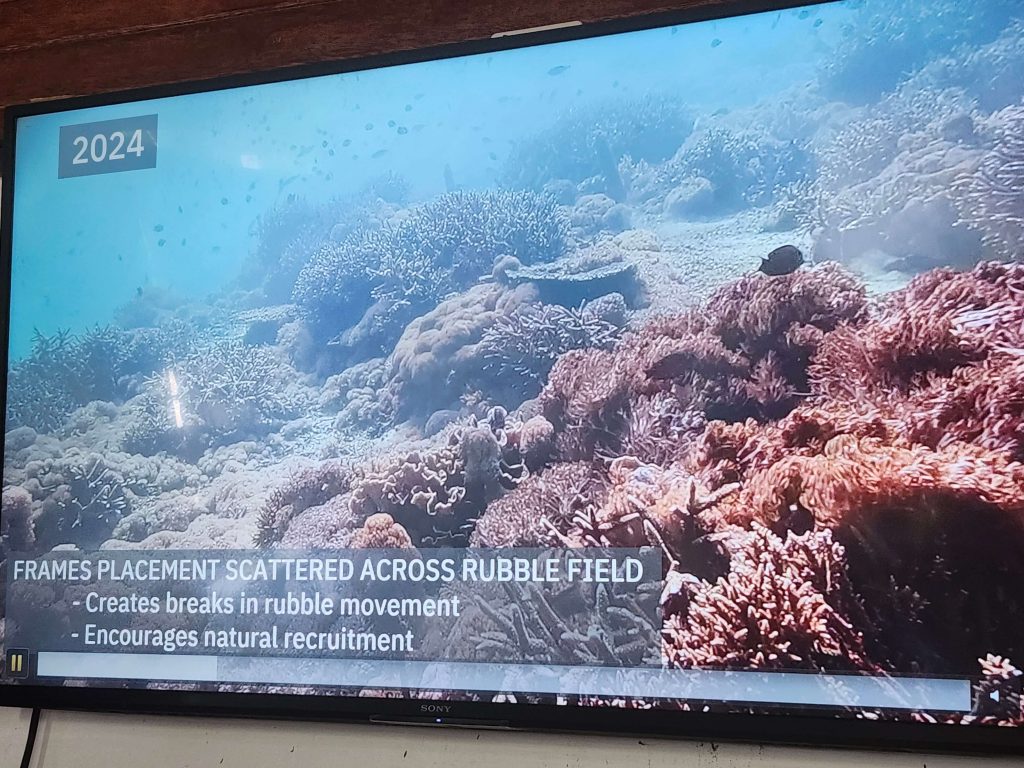
We started our restoration process by surveying the target area and where we wanted to put the frames to grow the coral from. There had been some recent illegal boat anchorages that created some damage spots. As the video pans around, remember this whole area was primarily rubble eight years ago.
We dropped frames down from the boat, moved them to the target locations we surveyed, and then hammered them into place.
We found pieces of coral that were still alive in a nearby rubble site and moved them to where the frames were.
We separated off dead sections of coral and cut them into small enough pieces to put on the frames.
One of the finished frames. They had tried many ways of securing the coral and plastic ties were the best. Using plastic is not ideal, but the coral will eventually completely grow over it and it wouldn’t provide any harm to the sea life. We came back the next day, once the coral settled in a bit, tightened the ties, and then cut off the parts extending out.
Here I am tying off a piece of foliose coral onto one of the frames.
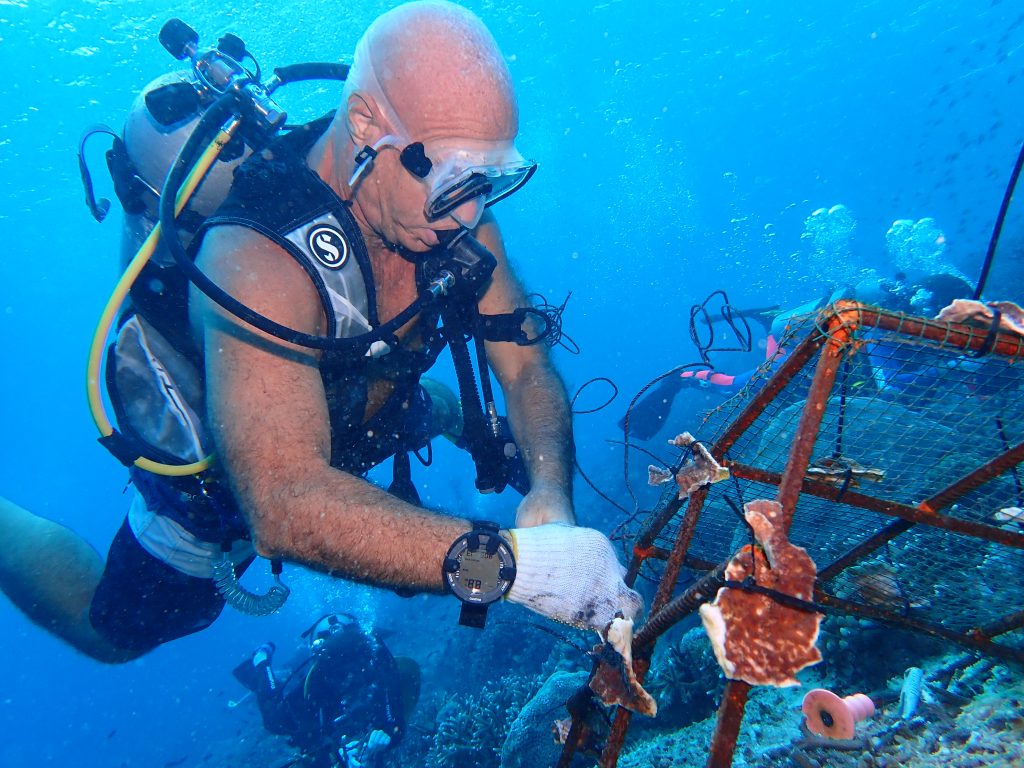
On the following dive we strung lines between the frames and tied branching coral to these lines to add more coral coverage and help further secure the frames.
On the final day we went to another new restoration site and added a score of coral lines between the frames. This entailed rounding up loose, living coral, knocking pieces into the right size for the lines, creating the lines, and then attaching them to the lines.
Our group (from Toronto, England, Italy and Switzerland) with Andrew and our wonderful Indonesian biologist dive guide, Egi, on the left.
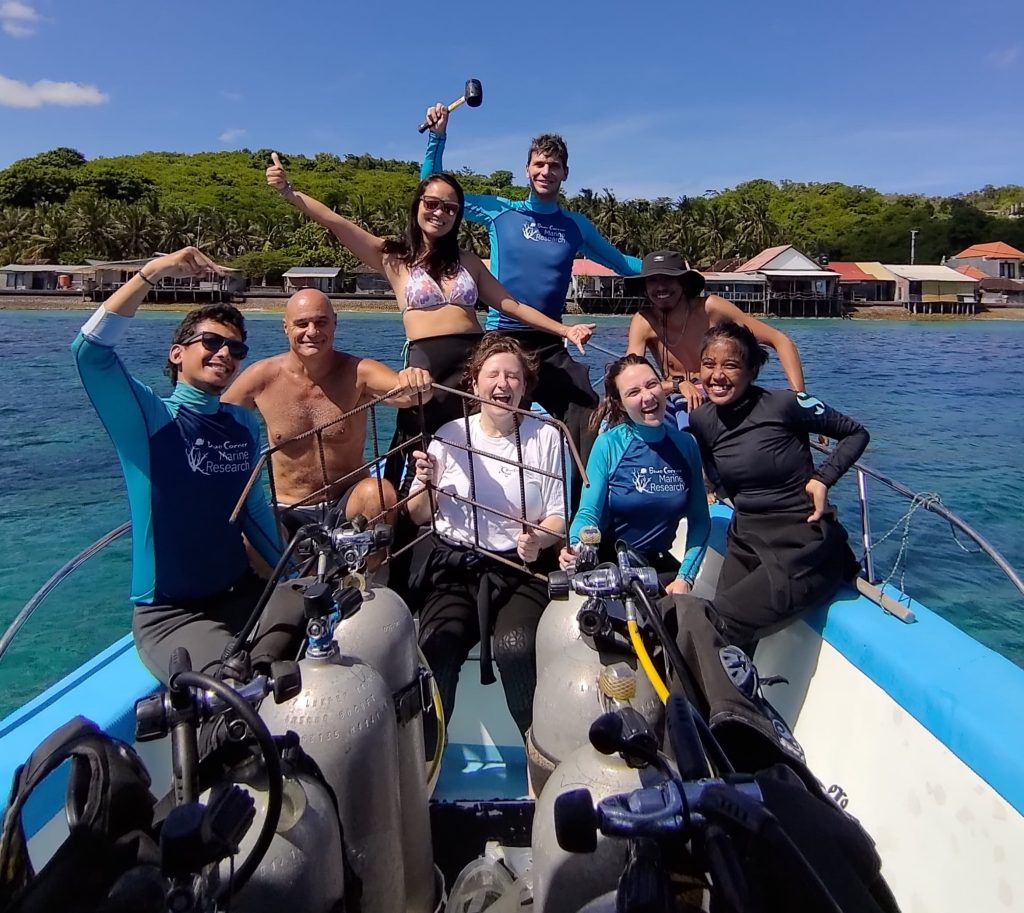
Marine Life Over the Three Weeks
Not every dive nor every part of most dives was purely work. As Andrew mentioned on the video, one of the great things about this area is the rich diversity of coral and sea life. The next few videos show some of that diversity.
A medley of hard coral shapes.
One of the draws of diving here is a manta cleaning station called Manta Point, where both divers and snorkelers congregate to see manta rays. Here’s a pure black manta; they are sometimes called ninja mantas. It’s mesmerizing watching these huge, graceful creatures float through the water.
Another visit to Manta Point and another manta encounter.
There were also scores of stingrays hiding and moving across the bottom of Manta Point.
It’s also a beautiful place above the surface.
The boatride to and from Manta Point provides a great vantage point of the cliffs of south Penida.
Thee is a rock outcropping next to Manta Point called Bat Rock. Most days the swell is too large to dive around it, but one day the swell was unusually small so Andrew asked if we wanted to try it for our second dive. He had only been there a few times before. Most of the rock was covered with low lying, colorful, hard corals. With the strong currents and swells there, any soft coral or higher hard corals would be washed away.
A couple of 4 month old baby white tip reef sharks were hiding under one of the coral restoration structures.
And another baby shark swam nearby.
We swam over a nice bamboo shark at Manta Point.
One of the most amazing animals are mantis shrimp. They have possibly the most sophisticated eyesight of any animal as well as one of the most powerful punches in the animal kingdom. Their strikes are exceptionally fast, with speeds exceeding 50 miles per hour, and they can produce forces comparable to a .22 caliber bullet. They are usually very shy, so to see two different ones not affected by me swimming over them was a unique sight.
A hungry turtle digging in for the perfect coral chunk to eat.
Another turtle foraging for coral.
We saw a lot of smaller sea life on our various dives. Here is a cuttlefish and then a scorpionfish using color to camouflage themselves on the bottom.
And a lethal stonefish hiding in the sand.
Here are two damselfish continuously cleaning their tiny eggs…at least when I wasn’t swimming near them to get a closer look at the eggs.
A moray eel out househunting.
A striking looking snowflake eel checking out the surroundings from beneath a large sponge.
A small, beautiful but menacing looking ribbon eel.
A couple of banded cleaner shrimp laying in wait under some coral.
An annoyed clownfish trying to figure how best to attack my camera.
A nice school of fusilier fish swimming around us.
Two long, skinny flute trumpetfish swimming slowly by.
A colorful clam among the rocks and coral.
Surfing
I did three days of surfing in Lembongan. It was the first time I had been on a board since surfing in Lombok almost 2 years ago. I was still able to catch nice 2-3 foot waves on a longboard and ride them in. While I definitely wasn’t the best surfer out there, it was nice to know I could still do the basics. But the third day the currents were pretty strong and my shoulders gave out, so I skipped the fourth day I had planned surfing. Sometimes the pain in the ass of paddling is more than the joy of riding a wave.
Since you needed to get a boat to get out to where the surf was, I used the wonderfully named Monkey Surf School.
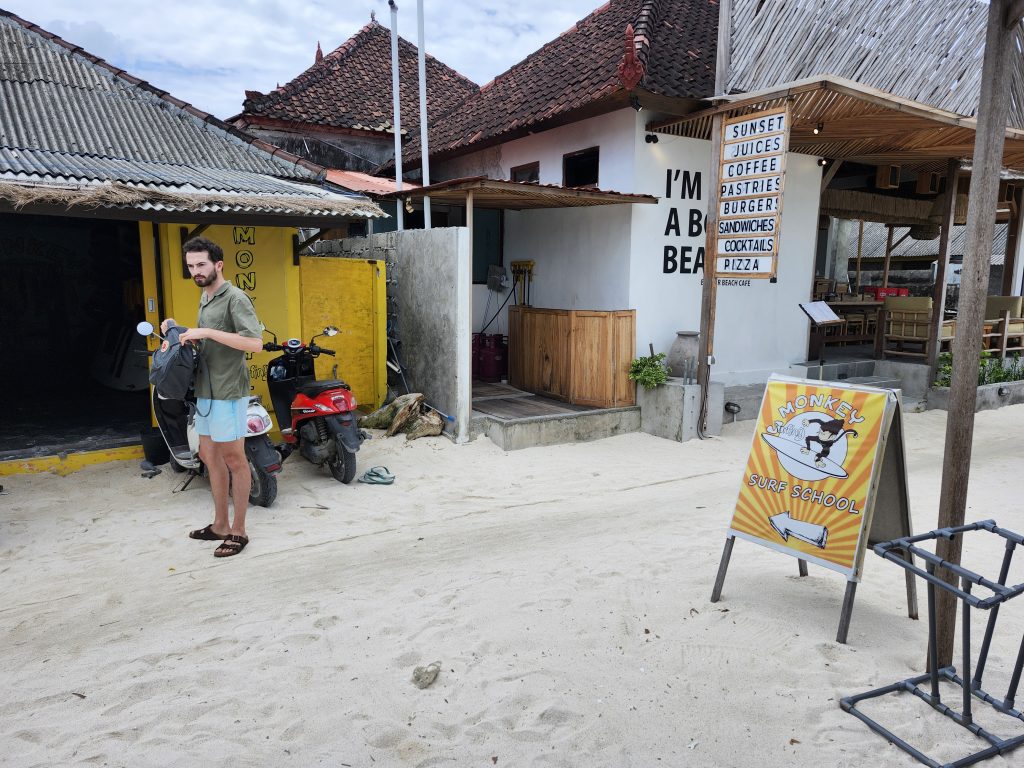
This really nice video provides a larger overview of surfing here. I was mostly at Lacerations and it was definitely much smaller when we went out than what these videos showed. The video has some nice shots of Lembongan as well.
Accomodations
I stayed at a small six room boutique hotel (which is called a homestay in Bali) in the middle of a dirt road. Here’s the entrance to the hotel.

The outside lobby area.

It was a really comfortable room.


The view from my porch area.

There was a narrow, bumpy dirt road to get from the hotel to the main road. But it was set in a very tranquil area. When it rained the road was a series of small lakes I had to navigate through on the scooter.
